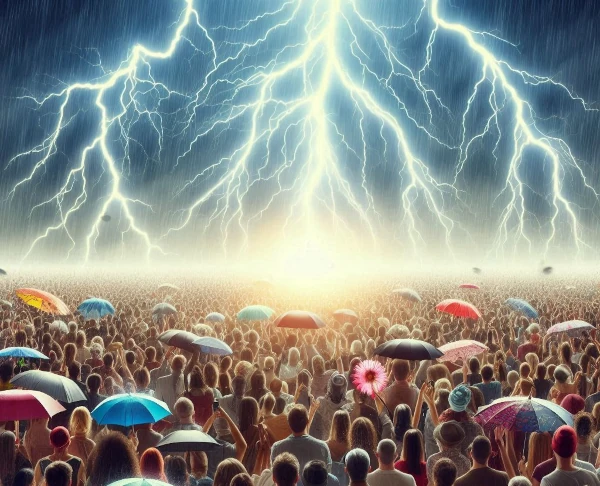
Image description: The phenomenon of electricity in the air and its implications for humanity. Image source: astronoo.com
Electricity in the air is a physical phenomenon that occurs when electrical charges accumulate in the atmosphere. This can manifest in various forms, such as lightning during thunderstorms. Lightning is the result of the electrical potential difference between clouds and the ground, or between different parts of a cloud. When this difference becomes sufficiently large, an electrical discharge occurs, creating a lightning bolt.
Weather conditions play a crucial role in the accumulation of these charges. Rapid vertical movements of air in thunderstorms, known as updrafts, separate electrical charges. Ice and water particles in the clouds rub against each other, creating positive and negative charges. Negative charges tend to accumulate at the base of the cloud, while positive charges are found at the top. This separation of charges creates an intense electric field, which can eventually cause an electrical discharge in the form of lightning.
Climate change exacerbates extreme weather conditions, increasing the frequency and intensity of thunderstorms. Rising global temperatures lead to increased evaporation from the oceans, which increases atmospheric humidity. This additional humidity fuels thunderstorm systems, making them more frequent and intense.
Furthermore, global warming alters atmospheric circulation patterns, creating conditions more favorable for the formation of violent storms. Updrafts in thunderstorms become more powerful, increasing the separation of electrical charges and, consequently, the likelihood of electrical discharges.
The human brain functions through electrical signals that propagate through a complex network of neurons. Neurons communicate with each other via electrical impulses called action potentials. These action potentials are generated by changes in the permeability of the cell membrane to ions, primarily sodium and potassium.
When a neuron is stimulated, ion channels in its membrane open, allowing sodium ions to enter the cell. This creates an electrical potential difference, or polarization, which travels along the neuron's axon. Once the action potential reaches the axon terminal, it triggers the release of neurotransmitters, which cross the synapse to stimulate the next neuron.
In addition to daily stresses, climate change introduces new sources of stress and uncertainty in our environment. This forces our brain to process an increased volume of increasingly anxiety-inducing information.
Extreme weather events, natural disasters, environmental degradation, food crises in certain regions, migrations, socio-economic crises, and the amplification of inequalities, the erosion of democratic rights, require constant adaptation and rapid decision-making.
These ongoing challenges increase the cognitive load, placing greater demands on the neural network. The brain must constantly evaluate risks, plan responses, and manage emotions associated with these environmental stresses, even when they do not directly affect us. This information overload can lead to mental fatigue and increased stress, affecting the overall well-being of humanity.
The collective stress related to the effects of climate and its consequences amplifies social vulnerabilities and extreme political behaviors. Faced with uncertainty and fear, an increasing number of individuals are turning to nationalist, radical, or authoritarian regimes or leaders.
Moreover, crises of all kinds are accumulating and running parallel. Democratic governments are perceived as incapable of managing complex, multidimensional crises. This is due to the slowness of decision-making processes, lack of international cooperation, conflicts of economic and political interests, etc.
The fear of the future in the face of recurring disasters causes a sense of sadness, helplessness, a phenomenon known as eco-anxiety. This phenomenon arises from the awareness of environmental degradation (climate change, loss of biodiversity, pollution) and fear of future consequences.
These chronic concerns, linked to global environmental threats, are exacerbated by increasing polarization of discourse, misinformation about climate issues, and generalized mistrust of institutions.
This collective psychological stress fosters the search for radical, even irrational, responses to situations perceived as unmanageable.
Climate change is not limited to physical phenomena such as increased electricity in the air; it also has profound impacts on mental health and the well-being of humanity. Increased stress and uncertainty in the face of an anxious future are pushing people to adopt increasingly radical political regimes, seeking quick and often extreme solutions.
These tensions exacerbate political divisions, fuel conflicts, and make intolerance towards others increasingly difficult to bear, as demographics continue to rise.